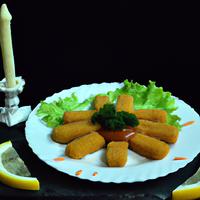
1 serving (100 grams) contains 200 calories, 10.0 grams of protein, 10.0 grams of fat, and 18.0 grams of carbohydrates.

Log this food in SnapCalorie

Nutrition Information
Calories |
480.8 | ||
|---|---|---|---|
% Daily Value* |
|||
| Total Fat | 24.0 g | 30% | |
| Saturated Fat | 4.8 g | 24% | |
| Polyunsaturated Fat | 0 g | ||
| Cholesterol | 48.1 mg | 16% | |
| Sodium | 961.5 mg | 41% | |
| Total Carbohydrates | 43.3 g | 15% | |
| Dietary Fiber | 2.4 g | 8% | |
| Sugars | 2.4 g | ||
| protein | 24.0 g | 48% | |
| Vitamin D | 240.4 mcg | 1202% | |
| Calcium | 48.1 mg | 3% | |
| Iron | 1.2 mg | 6% | |
| Potassium | 360.6 mg | 7% | |
* Percent Daily Values are based on a 2,000 calorie diet. Your daily values may be higher or lower depending on your calorie needs.
Food Attributes
Source of Calories
About Fishfingers
Fishfingers are crispy, breaded strips of fish typically made from white fish such as cod, haddock, or pollock. These convenient, ready-to-cook items originated in the UK in the mid-20th century and have since become a staple in Western cuisine, particularly for quick meals or snacks. While their crunchy coating and mild flavor make them popular among children and adults alike, their nutritional profile varies based on preparation methods and ingredients. Fishfingers can provide a source of lean protein and essential nutrients like omega-3 fatty acids if high-quality fish is used. However, they are often high in sodium and contain unhealthy fats due to frying or certain processed coatings. Opting for baked versions or pairing with fresh vegetables can improve their nutritional value. Fishfingers offer a versatile, easy-to-prepare meal option with both comfort and convenience, embodying a balance of indulgence and potential health benefits.



